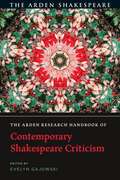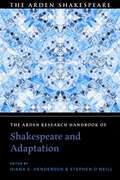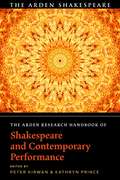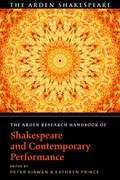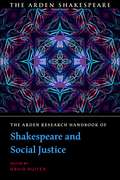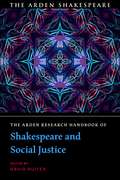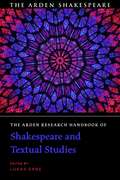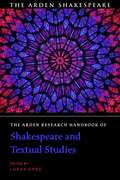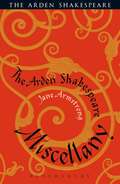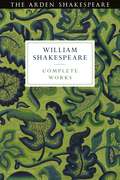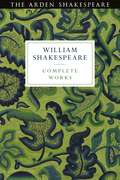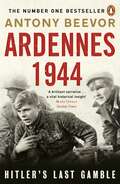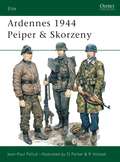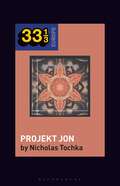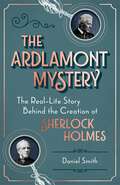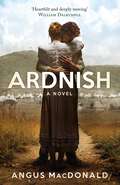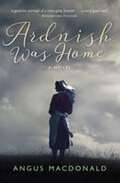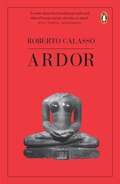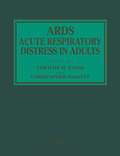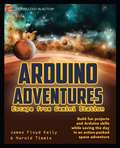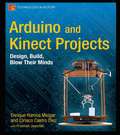- Table View
- List View
The Arden Research Handbook of Contemporary Shakespeare Criticism (The Arden Shakespeare Handbooks)
by Evelyn GajowskiThe Arden Research Handbook of Contemporary Shakespeare Criticism is a wide-ranging, authoritative guide to research on critical approaches to Shakespeare by an international team of leading scholars. It contains chapters on 20 specific critical practices, each grounded in analysis of a Shakespeare play. These practices range from foundational approaches including character studies, close reading and genre studies, through those that emerged in the 1970s and 1980s that challenged the preconceptions on which traditional liberal humanism is based, including feminism, cultural materialism and new historicism. Perspectives drawn from postcolonial, queer studies and critical race studies, besides more recent critical practices including presentism, ecofeminism and cognitive ethology all receive detailed treatment.In addition to its coverage of distinct critical approaches, the handbook contains various sections that provide non-specialists with practical help: an A–Z glossary of key terms and concepts, a chronology of major publications and events, an introduction to resources for study of the field and a substantial annotated bibliography.
The Arden Research Handbook of Shakespeare and Adaptation (The Arden Shakespeare Handbooks)
by Diana E. Henderson and Stephen O’NeillThe Arden Research Handbook of Shakespeare and Adaptation explores the dynamics of adapted Shakespeare across a range of literary genres and new media forms. This comprehensive reference and research resource maps the field of Shakespeare adaptation studies, identifying theories of adaptation, their application in practice and the methodologies that underpin them. It investigates current research and points towards future lines of enquiry for students, researchers and creative practitioners of Shakespeare adaptation. The opening section on research methods and problems considers definitions and theories of Shakespeare adaptation and emphasises how Shakespeare is both adaptor and adapted.A central section develops these theoretical concerns through a series of case studies that move across a range of genres, media forms and cultures to ask not only how Shakespeare is variously transfigured, hybridised and valorised through adaptational play, but also how adaptations produce interpretive communities, and within these potentially new literacies, modes of engagement and sensory pleasures. The volume's third section provides the reader with uniquely detailed insights into creative adaptation, with writers and practice-based researchers reflecting on their close collaborations with Shakespeare's works as an aesthetic, ethical and political encounter. The Handbook further establishes the conceptual parameters of the field through detailed, practical resources that will aid the specialist and non-specialist reader alike, including a guide to research resources and an annotated bibliography.
The Arden Research Handbook of Shakespeare and Adaptation (The Arden Shakespeare Handbooks)
The Arden Research Handbook of Shakespeare and Adaptation explores the dynamics of adapted Shakespeare across a range of literary genres and new media forms. This comprehensive reference and research resource maps the field of Shakespeare adaptation studies, identifying theories of adaptation, their application in practice and the methodologies that underpin them. It investigates current research and points towards future lines of enquiry for students, researchers and creative practitioners of Shakespeare adaptation. The opening section on research methods and problems considers definitions and theories of Shakespeare adaptation and emphasises how Shakespeare is both adaptor and adapted.A central section develops these theoretical concerns through a series of case studies that move across a range of genres, media forms and cultures to ask not only how Shakespeare is variously transfigured, hybridised and valorised through adaptational play, but also how adaptations produce interpretive communities, and within these potentially new literacies, modes of engagement and sensory pleasures. The volume's third section provides the reader with uniquely detailed insights into creative adaptation, with writers and practice-based researchers reflecting on their close collaborations with Shakespeare's works as an aesthetic, ethical and political encounter. The Handbook further establishes the conceptual parameters of the field through detailed, practical resources that will aid the specialist and non-specialist reader alike, including a guide to research resources and an annotated bibliography.
The Arden Research Handbook of Shakespeare and Contemporary Performance (The Arden Shakespeare Handbooks)
by Peter Kirwan and Kathryn PrinceThe Arden Research Handbook of Shakespeare and Contemporary Performance is a wide-ranging, authoritative guide to research on Shakespeare and performance studies by an international team of leading scholars. It contains chapters on the key methods and questions surrounding the performance event, the audience, and the archive – the primary sources on which performance studies draws. It identifies the recurring trends and fruitful lines of inquiry that are generating the most urgent work in the field, but also contextualises these within the histories and methods on which researchers build. A central section of research-focused essays offers case studies of present areas of enquiry, from new approaches to space, bodies and language to work on the technologies of remediation and original practices, from consideration of fandoms and the cultural capital invested in Shakespeare and his contemporaries to political and ethical interventions in performance practice. A distinctive feature of the volume is a curated section focusing on practitioners, in which leading directors, writers, actors, producers, and other theatre professionals comment on Shakespeare in performance and what they see as the key areas, challenges and provocations for researchers to explore.In addition, the Handbook contains various sections that provide non-specialists with practical help: an A-Z of key terms and concepts, a guide to research methods and problems, a chronology of major publications and events, an introduction to resources for study of the field, and a substantial annotated bibliography. The Arden Research Handbook of Shakespeare and Contemporary Performance is a reference work aimed at advanced undergraduate and graduate students as well as scholars and libraries, a guide to beginning or developing research in the field, and an essential companion for all those interested in Shakespeare and performance.
The Arden Research Handbook of Shakespeare and Contemporary Performance (The Arden Shakespeare Handbooks)
The Arden Research Handbook of Shakespeare and Contemporary Performance is a wide-ranging, authoritative guide to research on Shakespeare and performance studies by an international team of leading scholars. It contains chapters on the key methods and questions surrounding the performance event, the audience, and the archive – the primary sources on which performance studies draws. It identifies the recurring trends and fruitful lines of inquiry that are generating the most urgent work in the field, but also contextualises these within the histories and methods on which researchers build. A central section of research-focused essays offers case studies of present areas of enquiry, from new approaches to space, bodies and language to work on the technologies of remediation and original practices, from consideration of fandoms and the cultural capital invested in Shakespeare and his contemporaries to political and ethical interventions in performance practice. A distinctive feature of the volume is a curated section focusing on practitioners, in which leading directors, writers, actors, producers, and other theatre professionals comment on Shakespeare in performance and what they see as the key areas, challenges and provocations for researchers to explore.In addition, the Handbook contains various sections that provide non-specialists with practical help: an A-Z of key terms and concepts, a guide to research methods and problems, a chronology of major publications and events, an introduction to resources for study of the field, and a substantial annotated bibliography. The Arden Research Handbook of Shakespeare and Contemporary Performance is a reference work aimed at advanced undergraduate and graduate students as well as scholars and libraries, a guide to beginning or developing research in the field, and an essential companion for all those interested in Shakespeare and performance.
The Arden Research Handbook of Shakespeare and Social Justice (The Arden Shakespeare Handbooks)
by David RuiterThe Arden Research Handbook of Shakespeare and Social Justice is a wide-ranging, authoritative guide to research on Shakespeare and issues of social justice and arts activism by an international team of leading scholars, directors, arts activists, and educators. Across four sections it explores the relevance and responsibility of art to the real world ? to the significant teaching and learning, performance and practice, theory and economies that not only expand the discussion of literature and theatre, but also open the gates of engagement between the life of the mind and lived experience. The collection draws from noted scholars, writers and practitioners from around the globe to assert the power of art to question, disrupt and re-invigorate both the ties that bind and the barriers that divide us.A series of interviews with theatre practitioners and scholars opens the volume, establishing an initial portfolio of areas for research, exploration, and change. In Section 2 'The Practice of Shakespeare and Social Justice' contributors examine Shakespeare's place and possibilities in intervening on issues of race, class, gender and sexuality. Section 3 'The Performance of Shakespeare and Social Justice' traces Shakespeare and social justice in multiple global contexts; engaging productions grounded in the politics of Mexico, India, South Africa, China and aspects of Asian politics broadly, this section illuminates the burgeoning field of global production while keeping as a priority the political structures that make advocacy and resistance possible. The last section on 'Economies of Shakespeare' describes socio-economic and community issues that come to light in Shakespeare, and their potential to catalyse ongoing discussion and change in respect to wealth, distribution, equity, and humanity. An annotated bibliography provides further guidance to those researching the subject.
The Arden Research Handbook of Shakespeare and Social Justice (The Arden Shakespeare Handbooks)
The Arden Research Handbook of Shakespeare and Social Justice is a wide-ranging, authoritative guide to research on Shakespeare and issues of social justice and arts activism by an international team of leading scholars, directors, arts activists, and educators. Across four sections it explores the relevance and responsibility of art to the real world ? to the significant teaching and learning, performance and practice, theory and economies that not only expand the discussion of literature and theatre, but also open the gates of engagement between the life of the mind and lived experience. The collection draws from noted scholars, writers and practitioners from around the globe to assert the power of art to question, disrupt and re-invigorate both the ties that bind and the barriers that divide us.A series of interviews with theatre practitioners and scholars opens the volume, establishing an initial portfolio of areas for research, exploration, and change. In Section 2 'The Practice of Shakespeare and Social Justice' contributors examine Shakespeare's place and possibilities in intervening on issues of race, class, gender and sexuality. Section 3 'The Performance of Shakespeare and Social Justice' traces Shakespeare and social justice in multiple global contexts; engaging productions grounded in the politics of Mexico, India, South Africa, China and aspects of Asian politics broadly, this section illuminates the burgeoning field of global production while keeping as a priority the political structures that make advocacy and resistance possible. The last section on 'Economies of Shakespeare' describes socio-economic and community issues that come to light in Shakespeare, and their potential to catalyse ongoing discussion and change in respect to wealth, distribution, equity, and humanity. An annotated bibliography provides further guidance to those researching the subject.
The Arden Research Handbook of Shakespeare and Textual Studies (The Arden Shakespeare Handbooks)
by Lukas ErneThe Arden Research Handbook of Shakespeare and Textual Studies is a wide-ranging, authoritative guide to research on Shakespeare and textual studies by an international team of leading scholars. It contains chapters on all the major areas of current research, notably the Shakespeare manuscripts; the printed text and paratext in Shakespeare's early playbooks and poetry books; Shakespeare's place in the early modern book trade; Shakespeare's early readers, users, and collectors; the constitution and evolution of the Shakespeare canon from the sixteenth to the twenty-first century; Shakespeare's editors from the eighteenth to the twenty-first century; and the modern editorial reproduction of Shakespeare. The Handbook also devotes separate chapters to new directions and developments in research in the field, specifically in the areas of digital editing and of authorship attribution methodologies. In addition, the Companion contains various sections that provide non-specialists with practical help: an A-Z of key terms and concepts, a guide to research methods and problems, a chronology of major publications and events, an introduction to resources for study of the field, and a substantial annotated bibliography. The Arden Research Handbook of Shakespeare and Textual Studies is a reference work aimed at advanced undergraduate and graduate students as well as scholars and libraries, a guide to beginning or developing research in the field, an essential companion for all those interested in Shakespeare and textual studies.
The Arden Research Handbook of Shakespeare and Textual Studies (The Arden Shakespeare Handbooks)
The Arden Research Handbook of Shakespeare and Textual Studies is a wide-ranging, authoritative guide to research on Shakespeare and textual studies by an international team of leading scholars. It contains chapters on all the major areas of current research, notably the Shakespeare manuscripts; the printed text and paratext in Shakespeare's early playbooks and poetry books; Shakespeare's place in the early modern book trade; Shakespeare's early readers, users, and collectors; the constitution and evolution of the Shakespeare canon from the sixteenth to the twenty-first century; Shakespeare's editors from the eighteenth to the twenty-first century; and the modern editorial reproduction of Shakespeare. The Handbook also devotes separate chapters to new directions and developments in research in the field, specifically in the areas of digital editing and of authorship attribution methodologies. In addition, the Companion contains various sections that provide non-specialists with practical help: an A-Z of key terms and concepts, a guide to research methods and problems, a chronology of major publications and events, an introduction to resources for study of the field, and a substantial annotated bibliography. The Arden Research Handbook of Shakespeare and Textual Studies is a reference work aimed at advanced undergraduate and graduate students as well as scholars and libraries, a guide to beginning or developing research in the field, an essential companion for all those interested in Shakespeare and textual studies.
The Arden Shakespeare Miscellany
by Jane ArmstrongA gem of a reference book covering everything you could possibly want to know about Shakespeare between two handsome covers. Entries are quite short and range from "What did Shakespeare look like?", "Shakespeare on Film" and lists of compliments, oathes, lovers' vows and boys and girls names. There is an entry for each play too, summarising its plot and outlining major characters and themes. Details are given of the debates surrounding Shakespeare's identity, the known and fanciful facts of his life, and descriptions of the theatres in which he worked and the acting companies of which he was a member. A wealth of information and insight, both useful and entertainingly trivial, make this miscellany a book to satisfy students, buffs and bluffers alike.
The Arden Shakespeare Miscellany (Arden Shakespeare Library)
by Jane ArmstrongA gem of a reference book covering everything you could possibly want to know about Shakespeare between two handsome covers. Entries are quite short and range from "What did Shakespeare look like?", "Shakespeare on Film" and lists of compliments, oathes, lovers' vows and boys and girls names. There is an entry for each play too, summarising its plot and outlining major characters and themes. Details are given of the debates surrounding Shakespeare's identity, the known and fanciful facts of his life, and descriptions of the theatres in which he worked and the acting companies of which he was a member. A wealth of information and insight, both useful and entertainingly trivial, make this miscellany a book to satisfy students, buffs and bluffers alike.
Arden Shakespeare Third Series Complete Works (The Arden Shakespeare Third Series)
by Richard Proudfoot, Ann Thompson, David Scott Kastan and H.R. WoudhuysenThis new Complete Works marks the completion of the Arden Shakespeare Third Series and includes the complete plays, poems and sonnets, edited by leading international scholars. New to this edition are the 'apocryphal' plays, part-written by Shakespeare: Double Falsehood, Sir Thomas More and King Edward III. The anthology is unique in giving all three extant texts of Hamlet from Shakespeare's time: the first and second Quarto texts of 1603 and 1604-5, and the first Folio text of 1623.With a simple alphabetical arrangement the Complete Works are easy to navigate, and the reader's understanding and enjoyment are enhanced by the general introduction, short individual introductions to each text, a glossary and a bibliography. This handsome volume is ideal for readers keen to explore Shakespeare's work and for anyone building their literary library.
Arden Shakespeare Third Series Complete Works (The Arden Shakespeare Third Series)
This new Complete Works marks the completion of the Arden Shakespeare Third Series and includes the complete plays, poems and sonnets, edited by leading international scholars. New to this edition are the 'apocryphal' plays, part-written by Shakespeare: Double Falsehood, Sir Thomas More and King Edward III. The anthology is unique in giving all three extant texts of Hamlet from Shakespeare's time: the first and second Quarto texts of 1603 and 1604-5, and the first Folio text of 1623.With a simple alphabetical arrangement the Complete Works are easy to navigate, and the reader's understanding and enjoyment are enhanced by the general introduction, short individual introductions to each text, a glossary and a bibliography. This handsome volume is ideal for readers keen to explore Shakespeare's work and for anyone building their literary library.
Ardennes 1944: Hitler's Last Gamble
by Antony BeevorFrom the bestselling author of Stalingrad, Berlin and D-Day, Antony Beevor's Ardennes 1944: Hitler's Last Gamble tells the story of the German's ill-fated final stand.On 16 December, 1944, Hitler launched his 'last gamble' in the snow-covered forests and gorges of the Ardennes. He believed he could split the Allies by driving all the way to Antwerp, then force the Canadians and the British out of the war. Although his generals were doubtful of success, younger officers and NCOs were desperate to believe that their homes and families could be saved from the vengeful Red Army approaching from the east. Many were exultant at the prospect of striking back. The Ardennes offensive, with more than a million men involved, became the greatest battle of the war in western Europe. American troops, taken by surprise, found themselves fighting two panzer armies. Belgian civilians fled, justifiably afraid of German revenge. Panic spread even to Paris. While many American soldiers fled or surrendered, others held on heroically, creating breakwaters which slowed the German advance. The harsh winter conditions and the savagery of the battle became comparable to the eastern front. And after massacres by the Waffen-SS, even American generals approved when their men shot down surrendering Germans. The Ardennes was the battle which finally broke the back of the Wehrmacht.'Revealing, profound and thoroughly unputdownable, Stalingrad is an extraordinary achievement which transcends its genre' Vitali Vitaliev, Daily Telegraph (on Stalingrad)'This brilliant storyteller. . . makes us feel the chaos and the fear as if every drop of blood was our own: that is his gift. It is much more than just a humane account; it is compellingly readable, deeply researched and beautifully written' Simon Sebag Montefiore, Spectator (on Berlin)'This is a terrific, inspiring, heart-breaking book. It makes the argument all over again that the world would be an infinitely better place if it didn't keep producing subject matter for military historians: but as long as it does, we can rejoice that at the top of that profession is Antony Beevor' Sam Leith, Daily Mail (on D-Day)'His book is the definitive history. This is World War II as Tolstoy would have described it - the great and the small' Gerard DeGroot, Washington Post (on The Second World War)Antony Beevor is the renowned author of Stalingrad, which won the Samuel Johnson Prize, the Wolfson Prize for History and the Hawthornden Prize for Literature, and Berlin, which received the first Longman-History Today Trustees' Award. His books have appeared in thirty foreign editions and sold over six million copies.
Ardennes 1944 Peiper & Skorzeny (Elite)
by David Parker Jean-Paul PalludFrom the earliest planning stages of the German counter-offensive in the Ardennes, Hitler was convinced of the importance of taking the Meuse bridges. He resolved that, when his forces broke through the US lines, one special unit should be dressed in American uniforms and issued with American weapons and vehicles. In this guise they could take advantage of the surprise and shock of the breakthrough, and move forward to the Meuse bridges as if they were retreating Americans. Jean-Paul Pallud details their organisation and the fateful sequence of events that followed.
Ardennes 1944 Peiper & Skorzeny (Elite #11)
by David Parker Jean-Paul PalludFrom the earliest planning stages of the German counter-offensive in the Ardennes, Hitler was convinced of the importance of taking the Meuse bridges. He resolved that, when his forces broke through the US lines, one special unit should be dressed in American uniforms and issued with American weapons and vehicles. In this guise they could take advantage of the surprise and shock of the breakthrough, and move forward to the Meuse bridges as if they were retreating Americans. Jean-Paul Pallud details their organisation and the fateful sequence of events that followed.
Ardit Gjebrea’s Projekt Jon (33 1/3 Europe)
by Professor or Dr. Nicholas TochkaAs market reforms and migration transformed Albania in the early 1990s, Ardit Gjebrea began mixing traditional folk music with world music and Italian pop. The resulting album, Projekt Jon (1997), provided a new model for song-Western and cosmopolitan, yet firmly rooted in the fertile soil of the nation-against a backdrop of deepening political uncertainty about the very future of Albania. The Ionian Project announced itself with the frenetic beating of the daullë and the traditional cries of Albania's highland shepherd. This sprawling collaboration between singer-songwriter Ardit Gjebrea, folk singer Hysni Zela, producer Paul Mazzolini, and a team of crack studio musicians in Italy, had an outsized ambition: to transcend the small postsocialist nation-state's borders, imaginatively crafting through sound a new home in Europe for its citizens. But as Gjebrea prepared to launch Projekt Jon, violence prompted by the collapse of widespread pyramid schemes threatened to tear Albania apart. And for the intellectuals concerned about growing cracks in the symbolic foundations of the Albanian nation-state, the album came to serve as a referendum on the nature of postsocialist citizenship.
Ardit Gjebrea’s Projekt Jon (33 1/3 Europe)
by Professor or Dr. Nicholas TochkaAs market reforms and migration transformed Albania in the early 1990s, Ardit Gjebrea began mixing traditional folk music with world music and Italian pop. The resulting album, Projekt Jon (1997), provided a new model for song-Western and cosmopolitan, yet firmly rooted in the fertile soil of the nation-against a backdrop of deepening political uncertainty about the very future of Albania. The Ionian Project announced itself with the frenetic beating of the daullë and the traditional cries of Albania's highland shepherd. This sprawling collaboration between singer-songwriter Ardit Gjebrea, folk singer Hysni Zela, producer Paul Mazzolini, and a team of crack studio musicians in Italy, had an outsized ambition: to transcend the small postsocialist nation-state's borders, imaginatively crafting through sound a new home in Europe for its citizens. But as Gjebrea prepared to launch Projekt Jon, violence prompted by the collapse of widespread pyramid schemes threatened to tear Albania apart. And for the intellectuals concerned about growing cracks in the symbolic foundations of the Albanian nation-state, the album came to serve as a referendum on the nature of postsocialist citizenship.
The Ardlamont Mystery: The Real-Life Story Behind the Creation of Sherlock Holmes
by Daniel SmithThe real-life mystery featuring the two men – Joseph Bell and Henry Littlejohn – who inspired the creation of Sherlock Holmes.December 1893. Arthur Conan Doyle shocks his legions of fans by killing off the world’s favourite fictional detective, Sherlock Holmes. Meanwhile, in Scotland, a sensational real-life murder trial is playing out. Alfred Monson, a scion of the aristocracy, is charged with killing a young army lieutenant, Cecil Hambrough, on the sprawling Ardlamont estate. The worlds of crime fiction and crime fact are about to collide spectacularly.Among the key prosecution witnesses that the Ardlamont case brought together were two esteemed Edinburgh doctors, Joseph Bell and Henry Littlejohn. Bell – Doyle's tutor when the author studied medicine in the 1870s – had recently been unmasked as the inspiration behind the creation of Sherlock Holmes (Doyle said of Bell, ‘It is most certainly to you that I owe Sherlock Holmes…'). But what the public did not know was that Bell and Littlejohn – a pioneer in the emerging field of forensic detection – had actually been investigating crimes together for more than twenty years. Largely unacknowledged, Littlejohn deserves equal billing as the prototype of Baker Street's most famous resident.In The Ardlamont Mystery, author Daniel Smith re-examines the evidence of the case that gripped Victorian Britain, putting forward his own theory as to why Cecil Hambrough was murdered. Outlining the key roles of the men whose powers of deduction and detection had so inspired Doyle, Smith explores the real-world origins of Sherlock Holmes through the prism of a mystery as engrossing as any case the Great Detective ever tackled. Will Bell and Littlejohn’s shared faith in science and reason be enough to see justice win out?
Ardnish: A Novel (The\ardnish Ser. #2)
by Angus MacDonaldPraise for the Ardnish Series'What I really enjoyed about this book was its beauty, an enthralling read that is both brutal and poetic' – Daily Record‘A fast-paced narrative with deeply likeable characters ... far more than yet another wartime love story ... impossible to put down’ – Scottish Field, Book of the Month‘Not only a gripping and at times horrifying adventure . . . it is also an important piece of social history. But perhaps above all, it is a tale of the importance of true love and determination’ – Scots MagazineArdnish, the Highlands of Scotland, 1944. On his deathbed, Donald John Gillies sends for a priest to hear his last confession. During his 85 years he has witnessed much – world wars, the loss of family through death and emigration, and the daily struggles which face the small remote community.Waiting anxiously for the priest, his mind travels back to the dusty plains of South Africa in 1901, where he fought as a Lovat Scout during the Boer War, and where he met the woman who was the love of his life. Forced to abandon her and her young daughter in a British concentration camp, DJ returns to Scotland and his old life after his camp is ambushed by Boers and many of his fellow soldiers are massacred.As he lies dying, an unexpected visitor arrives at Ardnish. making it more imperative then ever for DJ to come to terms with the past and to make peace with himself – and his family – while there is still time.
Ardnish Was Home: A Novel (Ardnish Ser.)
by Angus MacDonaldGallipoli, 1915. Donald Peter Gillies, a young Lovat Scout soldier, lies in a field hospital, blinded by the Turks. There he falls in love with his Queen Alexandra Corps nurse, Louise, and she with him. As they talk in the quiet hours he tells her of life in the West Highlands of Scotland, where he grew up, and she in turn tells her own story of a harsh and unforgiving upbringing in the Welsh valleys. Cut off from Allied troops, Donald and Louise make a perilous escape through Turkey, Greece and on to Malta – the first stage on their journey to a new life together in Donald’s beloved Ardnish. But just as they are within reach of home, Fate deals an unexpected hand . . .
Ardor
by Roberto CalassoIn this revelatory volume, Roberto Calasso, whom the Paris Review has called 'a literary institution', explores the ancient texts known as the Vedas. Little is known about the Vedic people who lived more than three thousand years ago in northern India: they left behind almost no objects, images, ruins. They created no empires. Even the hallucinogenic plant, the soma, which appears at the centre of some of their rituals, has not been identified with any certainty. Only a 'Parthenon of words' remains: verses and formulations suggesting a daring understanding of life. 'If the Vedic people had been asked why they did not build cities,' writes Calasso, 'they could have replied: we did not seek power, but rapture.' This is the ardor of the Vedic world, a burning intensity that is always present, both in the mind and in the cosmos. With his signature erudition and profound sense of the past, Calasso explores the enigmatic web of ritual and myth that define the Vedas. Often at odds with modern thought, he shows how these texts illuminate the nature of consciousness more than neuroscientists have been able to offer us up to now. Following the 'hundred paths' of the Satapatha Brahmana, an impressive exegesis of Vedic ritual, Ardor indicates that it may be possible to reach what is closest by passing through that which is most remote, as 'the whole of Vedic India was an attempt to think further'.
ARDS Acute Respiratory Distress in Adults
by Timothy W. Evans C. HaslettGreat progress has been made since the first description of the acute respiratory distress syndrome by the Denver group in 1967 (Lancet). Although we introduced the term 'adult respiratory distress syndrome' in our second and more detailed description of the syndrome (ehest, 1971), this was probably amistake for the simple reason that children also suffer the same syndrome fo11owing acute lung insults. Today, the syndrome of acute respiratory distress in adults (ARDS) is recognized as a worldwide problem, but the prevalence of disease varies in different parts of the world. A huge amount of research has focused on the mechanisms of acute lung injury and yet the exact sequence of events and media tors in inflammatory cascade, which result in acute respiratory failure from ARDS, is not known but many possibilities exist. The definition of ARDS has been gradua11y modified in recent years and investigators around the world are now co11aborating in order to establish more uniform concepts in identification, risk factors and mechanisms of lung injury, which someday will result in improved approaches to management. Already, at least some centers are showing improved outcomes in ARDS, achieving an approximate 60% survival rate. In the past, most large series documented only about a 40% survivability taking a11 causes of ARDS. This apparent progress is likely attributable to more meticulous and disciplined care than any specific pharmacologic attack on the basic mechanism resulting in ARDS.
Arduino Adventures: Escape from Gemini Station
by James Floyd Kelly Harold TimmisArduino Adventures: Escape from Gemini Station provides a fun introduction to the Arduino microcontroller by putting you (the reader) into the action of a science fiction adventure story. You'll find yourself following along as Cade and Elle explore Gemini Station—an orbiting museum dedicated to preserving and sharing technology throughout the centuries. Trouble ensues. The station is evacuated, including Cade and Elle's class that was visiting the station on a field trip. Cade and Elle don&’t make it aboard their shuttle and are trapped on the station along with a friendly artificial intelligence named Andrew who wants to help them get off the damaged station. Using some old hardware, a laptop, and some toolboxes full of electronics parts, you will follow along and build eight gizmos with Cade and Elle that will help them escape from Gemini Station. The hardware is Arduino. Each new challenge opens a new area of Arduino and basic electronics knowledge. You&’ll be taken incrementally from a simple task such as turning on a light through to a complex combination of microcontroller, electronic components, and software programming. By the end of the book you&’ll be well on your way towards being able to create and implement any sort of electronically controlled device you can imagine, using the stunningly popular Arduino microcontroller. Provides eight challenges, each challenge increasing in complexity Builds around a fictional storyline that keeps the learning fun Leaves you on a solid foundation of electronic skills and knowledge
Arduino and Kinect Projects: Design, Build, Blow Their Minds
by Enrique Ramos Melgar Ciriaco Castro DiezIf you've done some Arduino tinkering and wondered how you could incorporate the Kinect—or the other way around—then this book is for you. The authors of Arduino and Kinect Projects will show you how to create 10 amazing, creative projects, from simple to complex. You'll also find out how to incorporate Processing in your project design—a language very similar to the Arduino language. The ten projects are carefully designed to build on your skills at every step. Starting with the Arduino and Kinect equivalent of "Hello, World," the authors will take you through a diverse range of projects that showcase the huge range of possibilities that open up when Kinect and Arduino are combined. Gesture-based Remote Control. Control devices and home appliances with hand gestures. Kinect-networked Puppet. Play with a physical puppet remotely using your whole body. Mood Lamps. Build your own set of responsive, gesture controllable LED lamps. Drawing Robot. Control a drawing robot using a Kinect-based tangible table. Remote-controlled Vehicle. Use your body gestures to control a smart vehicle. Biometric Station. Use the Kinect for biometric recognition and checking Body Mass Indexes. 3D Modeling Interface. Learn how to use the Arduino LilyPad to build a wearable 3D modelling interface. 360º Scanner. Build a turntable scanner and scan any object 360º using only one Kinect. Delta Robot. Build and control your own fast and accurate parallel robot.
